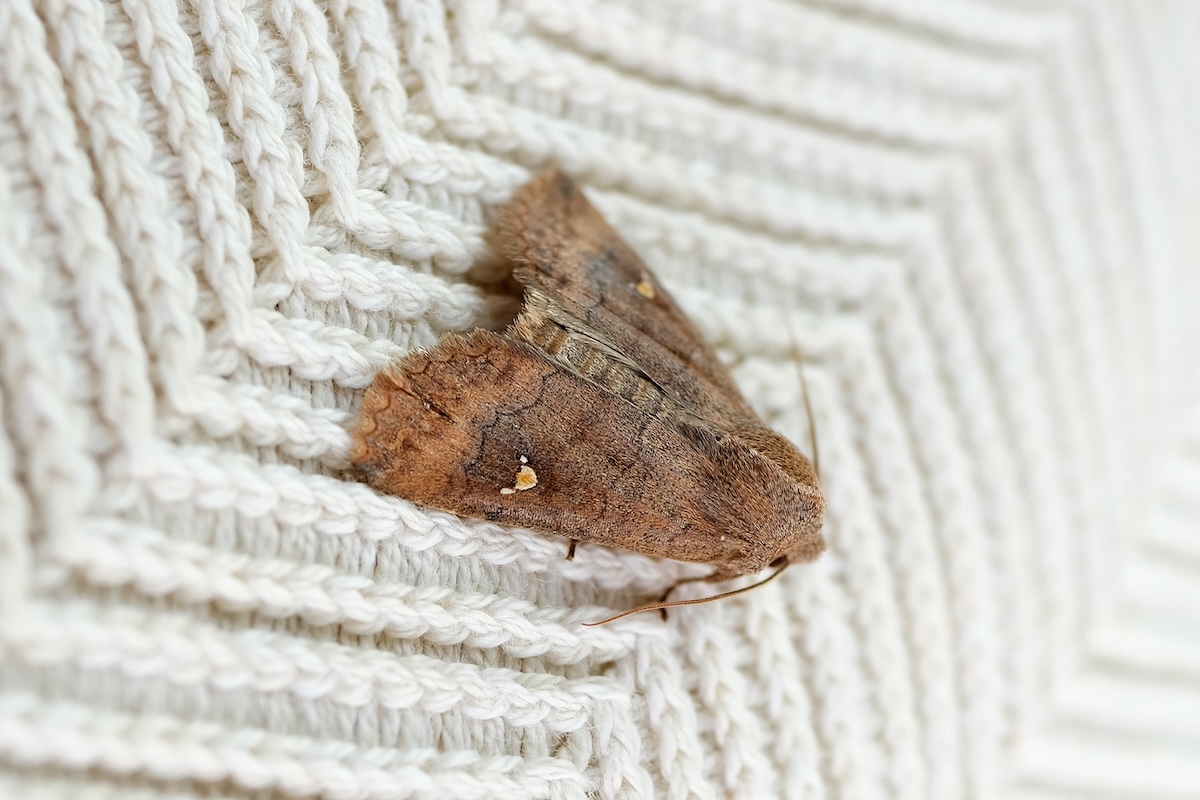

We may earn revenue from the products available on this page and participate in affiliate programs. Learn More ›
Several types of moths can infiltrate your home, destroying clothing and other textiles and burrowing into foodstuffs in your pantry, making grains, cereal, rice, flour, nuts, dried fruit, and other provisions inedible.
While, with diligence, you can eradicate moths, your best strategy is prevention. If you live in an area where moths are a problem, take steps to keep moths from taking root in your home. If you’ve already fallen victim to an invasion, learn how to get rid of moths in the house.
Types of Moths
While there are somewhere around 160,000 moth species on the planet, luckily we only have to worry about a few types of moths that might potentially invade our homes.
Pantry
Sometimes called Indian meal moths, adult Plodia interpunctella moths are about the size of a cooked grain of rice. Their wings are reddish-brown with a dark tan stripe and black splotches; the larvae, at about ½-inch long, are creamy white. You can unwittingly bring them into your home in purchased products. “Warehouses can have stored-product pest issues, same as the stores or secondhand goods,” says Kyle Morgan, founder of Care Pest Pros in Spicewood, Texas.
Pantry moth larvae feed on cereals, flour, nuts, chocolate, dried fruits, spices, and pasta. They’ll also eat birdseed, dog food, and dried flowers. “Another place that I have found them is in potpourri in bathrooms and Rid-X for septic systems (it contains yeast),” Morgan adds.
Clothes
Two types of clothes moths make themselves at home in the closets of North America. The larvae of casemaking clothes moth (Tinea pellionella) and webbing clothes moth (Tineola bisselliella) are destructive pests that chew through animal-based natural textiles such as leather, wool, fur, silk, feathers, and natural-fiber felt. While they’re typically not attracted to plant-based fibers, such as cotton, they might attack these items if they sense human presence—sweat, blood, body oils, or food stains.
The adult webbing clothes moths are about ¼ inch long and have gray/tan/black mottled wings; the larvae are shiny white with a black head. Adult casemaking clothes moths look similar to webbing clothes moths, and their larvae also look alike—½ inch long, white body, black head—except the casemaking clothes moth larvae carry a silken case with them as they feed.
Brown House
The wings of Hofmannophila pseudospretella are light brown/tan with black splotches. Their larvae are similar to others, with dull translucent bodies and tan heads. The adult wings have spotting that is darker than their brownish bodies and a fringed appearance at the bottom. Like clothes moths, brown house moths eat textiles, and like pantry moths, they’ll also eat grains.
Diamondback
Sometimes called cabbage moth, Plutella xylostella is not typically found indoors, since these moths are plant eaters. Still, they are attracted to light and might come into your home seeking brightness. They can also enter the home on vegetables brought inside. The larvae are light green caterpillars about a third of an inch long. Adults are slim and gray-brown.
Miller
Miller moth can refer to any of a number of moths whose larval stage is sometimes called army cutworm. Typically gray-black in both immature and adult phases, these moths feed on vegetation, and typically aren’t interested in closets or pantries, but will enter homes. Large infestations can lead to staining of drapes or other surfaces as they emit fluid.
Ways to Get Rid of Moths

Getting rid of pantry or clothes moths invading your home boils down to prevention first. But if they’re already a problem, you can take steps to get rid of these moths.
How to Get Rid of Pantry Moths
Although you might be able to identify pantry moths from the adults’ appearance, other signs include pupal cases or cocoons and damage to grain products. Look for pupae attached to bags or small holes in packages.
- Remove everything from your pantry, carefully wiping down and inspecting each item as you remove it.
- Check all grains, cereals, flour, rice, pasta, nuts, and dried fruit for signs of infestation. Because moth eggs are nearly impossible to see with the naked eye, consider getting rid of all foodstuffs that could harbor the eggs. Alternatively, you can place potentially affected foodstuffs in sealed plastic bags and put them in the freezer for 72 hours, which will kill any eggs.
- Place known infected items in sealable plastic bags and take them to the outside trash immediately.
- Using the crevice tool on your vacuum cleaner, thoroughly clean the pantry floors and shelves. Take the vacuum bag to an outdoor trash bin, or, once outside, empty the canister into a sealable bag and discard it in an outside receptacle.
- Wipe down every pantry surface with a mixture of hot water and dish soap.
- When restocking the pantry, put food in tightly sealed containers.
- Install pheromone traps, which will attract any lingering bugs, as they can be an effective treatment, Morgan says. “You just need to make sure to ID the moth correctly, in order to use the correct pheromone trap,” he adds.
How to Get Rid of Clothes Moths
Aside from seeing the ¼- to ½-inch adult moths in your home, signs of clothes moths most often appear in hidden locations like the crevices of furniture or under collars of shirts. If you suspect clothes moths, take these steps:
- Empty the entire closet, taking items directly outside if it’s practical.
- Inspect natural fiber items. Discard, in sealed plastic bags, items that are damaged beyond repair.
- Wash all washable items in hot water (120 degrees Fahrenheit or hotter), and dry in high heat if the fabric will tolerate it, Morgan says.
- Place items that can’t be washed in sealed plastic bags and leave them in the freezer for 72 hours.
- Vacuum the floor and shelves of the closet; empty the vacuum as described above.
- Wipe down shelves, baseboards, and furniture with warm, soapy water.
- As you replace closet contents, consider placing vulnerable items into sealable plastic bags or containers.
- Install pheromone traps.
Preventing Moths: What Works, What Doesn’t

To prevent an infestation of moths, Morgan says eliminating food sources is the most important measure a homeowner can take. For clothes moths, he says, “We recommend storing animal-based fibers in vacuum bags or airtight hard plastic containers when they’re not being worn.” For pantry moths, he says to store dry goods in “airtight glass, metal, or hard plastic containers—not just cardboard or thin plastic, as I’ve seen them chew right through these to get to what’s inside.” Regular cleaning under furniture, along baseboards, or where hair and debris accumulate can help deter moths.
Some homeowners have reported good luck with cedar oil as a moth repellent. Rub the oil into a square of cedarwood and place in your closet or pantry. But be sure to refresh the cedar annually, if not more often, when you notice the scent beginning to dissipate. Sand the cedar blocks down a bit to release fresh scent, and then reapply the cedar oil.
Mothballs are highly toxic to pets and people and best not used in the family home. Other common folk remedies for deterring moths—bay leaves and spearmint gum—probably don’t have any real impact, either, according to experts. You can, however, leave a light on in the clothes closet, if practical, and use an LED light that is energy efficient, because closet moth larvae prefer dark areas. Pantry moth adults are attracted to light, so don’t leave a light on in the pantry.
When to Call Pest Control for a Moth Infestation
If you’ve tried all the elimination methods above to no avail, you might need to call in the experts. The pros have advanced knowledge of the behaviors of these pests and will use their extensive experience and expertise to track the moths down and eliminate them. “There may be a missed food source we can help track down,” Morgan says. “Sometimes this is related to dead animals in the attic/walls/or below the home that attract the clothes moths, or rodents with a nut stash in your walls attracting pantry moths.”
FAQ
To get rid of moths, do a thorough cleanup as described above. No shortcuts! When you’re finished cleaning, install pheromone traps to attract any lingering moths. If these steps fail, call in the pros.
Like many creatures, moths are constantly searching for a source of food. They come in the house because they are attracted to light, or get carried in on infected food items. If they find the food they’re looking for, they’ll stick around and reproduce.
When it comes to how to repel moths, cedar oil is the best natural moth repellent. But remember to occasionally refresh the cedar oil repellent so it remains effective.






